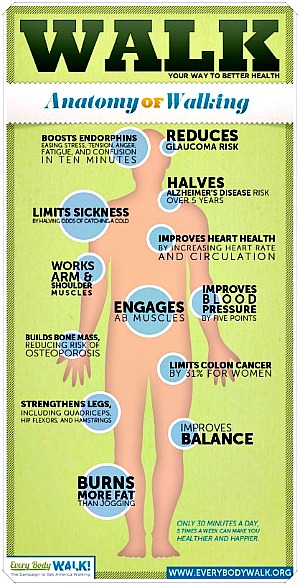Health benefits

“Walking is like medicine for my patients. If walking was a pill or surgical procedure, it would be on 60 Minutes.” Dr. Bob Sallis
Australia has one of the highest rates of obesity in the world, with the total cost of obesity in Victoria estimated to be $14.4 billion in 2008 (Access Economics 2008).
Lack of ‘incidental’ physical activity such as walking and cycling for transport is a contributing factor to high rates of obesity for both children and adults. Countries, states and towns with the highest levels of active transport tend to have the lowest rates of obesity (Pucher et al 2010). People who live in sprawling suburbs are more likely to be obese and suffer from high blood pressure, as recorded in Measuring the Health Effects of Sprawl.
Daily walking or cycling to and from work reduces the risk of coronary heart disease (Hu et al 2007). Walking is quite literally the best medicine for type 2 diabetes - brisk walking for an hour a day has been associated with a 34% reduction in risk (Hu 2011).
There are multiple ways to achieve significant health benefits from walking, to meet health guidelines of 30 minutes daily activity for adults. Walking can be built into everyday life, including:
• Recreational walking
• Walking to access jobs, shops or schools
• Walking to public transport.
As an example, public transport users in metropolitan Melbourne average 28 minutes walking to and from public transport each day, plus six minutes walking for other purposes, while car travellers average only six minutes in total (Pedestrian Access Strategy 2010). As a result, there is evidence that travel to work by any method other than a car will have health benefits. A recent study of 822 adults in Adelaide found average weight gain over four years of 1.26kg for non–car commuters; 1.53kg for occasional car commuters; and 2.18kg for daily car commuters (Sugiyama et al 2013).
A European study estimated that a person who switched from driving to walking for a 2.5km journey to work would experience health benefits worth €1300 per annum (Rabl and Nazelle 2011).
The health benefits of walking are also outlined in the UK report Walking Works.
What if you're already sick?

Physical exercise including walking will continue to provide health benefits when people are affected by serious illness, in fact there is no more important time to exercise.
Cancer studies helpfully summarised in The Conversation include:
- A long-term study of a large group of women in the United States, some of whom later developed breast or bowel cancer, found that those who self-reported higher levels of physical activity had a much lower rate (up to 50%) of cancer recurrence.
- A follow up of nearly 3,000 nurses found that those meeting current U.S. physical activity guidelines (such as brisk walking) almost halved their risk of death from breast cancer compared with those who were sedentary.
- In the nurses who developed bowel cancer, those exercising more than the physical activity recommendations halved their risk of dying.
- Another study in both men and women with colon cancer found that people doing more than the recommended minimum of physical activity each week reduced the risk of their cancer returning (at three years) by about half.
A study of people with Parkinsons disease, reported in the Los Angeles Times, found improvements in aerobic fitness, motor function, mood, fatigue levels and quality of life for those who walked regularly for exercise.
Exercise may be just as effective at treating illness as the available medicine. The study Comparative effectiveness of exercise and drug interventions on mortality outcomes is summarised in Global PANet and detailed in the British Medical Journal (BMJ). It found no statistically significant difference between exercise and drug interventions in the secondary prevention of coronary heart disease and prediabetes. It found that exercise was actually more effective than drug treatment in patients with stroke. The only drug found to be more effective than exercise was diuretics in relation to heart failure.